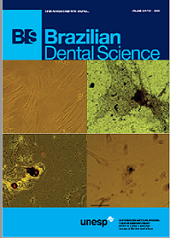Evaluation of the influence of malocclusion in interpersonal relations among adolescents
DOI:
https://doi.org/10.14295/bds.2020.v23i1.1799Abstract
Aim: To evaluate the influence of malocclusion on interpersonal relationships among adolescents. Method: A cross-sectional, quantitative study was carried out with 360 students. Photographs of male and female mouth with malocclusions were manipulated and superimposed on the smile images of two individuals of both genders with normal occlusion (corresponding to the control group, GC) respectively, for assembly of 4 malocclusions: (1) anterior open bite, ( 2) anterior crossbite (3) dental crowding , and (4) Class II, in this order. These images were provided to the participants, who evaluated them through a questionnaire. Results: The less attractive malocclusion was dental crowding. For both flirting and maintaining a serious relationship the previous open bite was the most rejected, with Class II being the most acceptable. Conclusion: For adolescents, dental crowding is the most appropriate malocclusion to be corrected orthodontically. Malocclusions negatively influence the development of interpersonal relationships among adolescents.
KEYWORDS
Adolescent; Malocclusion; Interpersonal relationships.
Downloads
Downloads
Additional Files
Published
How to Cite
Issue
Section
License
Brazilian Dental Science uses the Creative Commons (CC-BY 4.0) license, thus preserving the integrity of articles in an open access environment. The journal allows the author to retain publishing rights without restrictions.
=================




























